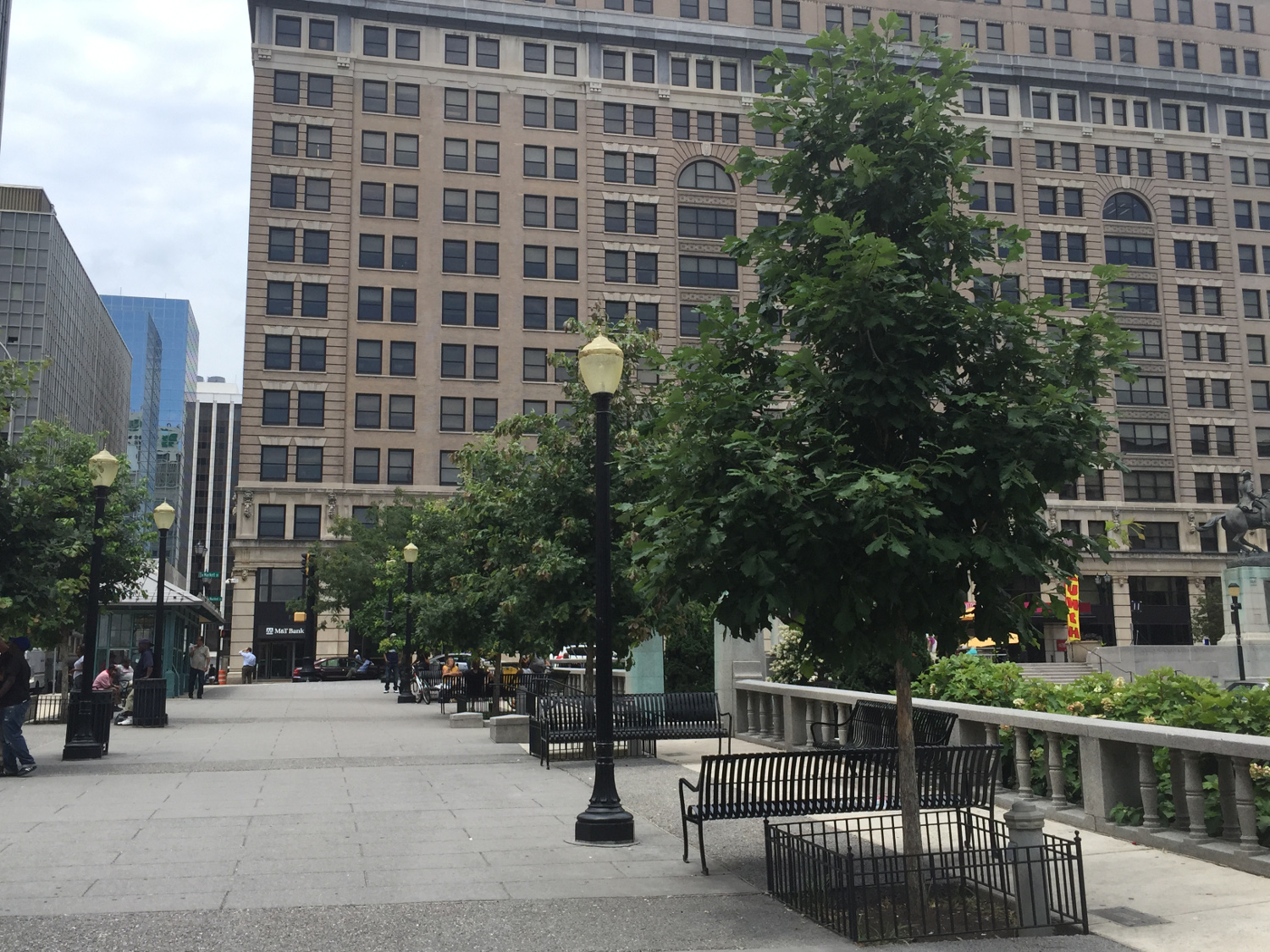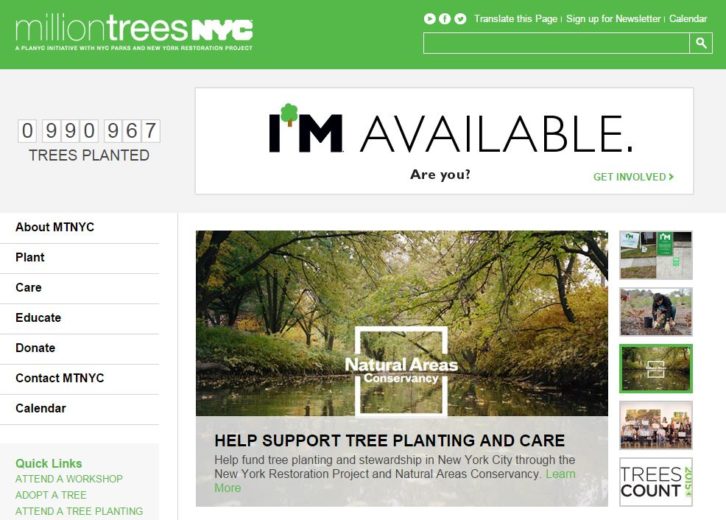In 1982, I was in China studying landscape architecture and architecture at the University of Nanjing. The central Chinese government had recently announced they would recommit to a nationwide multi-billion tree planting program, originally initiated in 1978. By then the Cultural Revolution was over, Mao Zedong was dead, the Gang of 4 had been jailed, and Deng Xiaoping had thrown the doors open to Western Capitalism. Still, the idea of the “5 year plan” was very much alive.
While in Nanjing city (Jiangsu Province, east central China) I witnessed a portion of that major tree planting plan in action in an urban area. It was an eye-opening experience, something like a mobile assembly line, a kind of time and motion dance in action.
First, small groups of men set upon, broke up, and removed 1m x 1m (4′ x 4′) concrete squares of sidewalk by hand. Then, an open bed truck with several more workers shoveled the broken concrete onto the truck, and dug a small tree hole about 61cm (2’) wide and deep.
Next came a flatbed truck with the trees, each like a giant upside-down lollipop. These trees had trunks approximately 30cm (12”) in diameter and about 2.4m (8’) tall. The lollipop portion was a root ball about 2’ (60cm) in diameter with a few large, exposed, and pruned back roots with no visible soil. Most surprisingly, there were no branches on any of the trees. The lollipop trees, every one of them a London Plane (Platanus x acerifolia), were each dropped into a hole and then filled with dirst by another group of workers. The last step in the process was a water truck with a 15cm (6”) diameter hose; one driver and one hose operator doused each tree for about 10 to 15 seconds.
While impressive in scope and drama, what were the actual results?
Unfortunately there are no studies I know of that describe the success rate of the radical urban tree planting approach that I witnessed in Nanjing, but generalized studies of Chinese tree planting initiatives at these large scales in the 1980’s listed typical success rates of between 45% to 55% (Chokkalingam et al 2006). I have no reason to believe that these London Plane urban tree plantings were much different, though I always wanted to know.
Million Tree Plantings: Truth in Advertising?
Beginning in the mid-2000s, various large city mayors (primarily in North America, with some in Europe and Asia) started making announcements of large tree planting initiatives that their cities would undertake in rapid time spans: New York City (1 million trees within a decade of starting), Los Angeles (this started as a “plant 1 million” campaign and has since changed its name and its mission), and London (2 million trees by 2025) to name just a few.
I believe New York City will reach their goal – according to their website, they are quite close – but this is not the case for any other city as far as I am aware (New York City did something worth noting: they developed a contract growing agreement with nurseries in order to control the quality of the stock they were planting). In my opinion, most other planting programs were designed to establish a city’s “green” bona fides without spending much money or exerting much effort. In large measure these announcements were aspirational, because there is no evidence that a large-scale concerted effort is underway in planting anything even close to those numbers of trees in those cities.
What’s the Real Cost of Planting Trees Improperly?
A few years ago, my colleague Nathalie Shanstrom and I wrote a whitepaper, “Investment Versus Returns for Health Urban Trees” analyzing the true cost of a street tree when planted properly (1,000 ft3 of loam per tree) or improperly (64 ft3 of loam per tree).
To complete our analysis, we calculated the cost of both planting types based on public bid tabulations from Minneapolis, MN. We estimated as conservative, or costly, for the properly planted trees and as inexpensively as possible for the improperly planted trees.
Using i-Tree, we modeled the net benefits and losses to a city from planting a street tree in the two scenarios described above over a 50 year time span. I-Tree is a prodigiously researched and rigorously modeled tree costs/benefits program; it has supplanted all other previous tree modeling programs and is the worldwide standard. The primary cost/benefit categories are installation and removal, operations and maintenance, carbon sequestration, heating and cooling energy savings, air-quality, and stormwater treatment. We also added property value and stormwater utility fee savings (based on rates for Minneapolis, MN).
We found that the true costs of planting trees properly or improperly were even more dramatic than we expected – with drastic implications over the decades of a tree’s potential lifespan.
| Improper planting | Proper planting | |
| Benefits over 50 years | $2,717.66 | $41,769.00 |
| Costs over 50 years | $5,811.95 | $16,341.75 |
| Net lifecycle cost over 50 years | -$3,094.29 | $25,427.22 |
| Return on investment after 50 years | -47% | 250% |
Two Ways of Planting Trees
Planting a street tree improperly is pretty simple and, on its face, inexpensive. The installed cost of an improperly planted street tree is approximately $1,000 USD, and likely has a likely life span of 7, 13, or 23 years (Skiera and Moll, 1992). Here’s how to plant a street tree improperly in 10 easy steps.
- Cut a 4′ x 4′ hole in a concrete sidewalk and remove concrete.
- Excavate down 4′ deep, remove sub-base and fill, replace with loam soil.
- Place a 2 inch caliper tree with a balled and burlapped root package in the hole.
- Remove the strings, ropes, cords and burlap from the top of the root ball.
- The top of the exposed root ball should be level with the surrounding dirt.
- Place loam around the root ball edge to eliminate air pockets.
- Place several inches of wood chip mulch against the trunk and on top of the root ball, similar to a volcano.
- Water in root ball thoroughly.
- Stake and then use guy lines to straighten tree trunk.
- Water root ball several more times during that growing season.
In contrast, here’s how to plant a tree properly in 10 steps.
- Calculate and create a soil volume under paving (sidewalks, plazas, parking lots, etc.) of at least 1,000 cubic feet per tree.
- Create, at minimum, a 5′ x 5′ tree pit openings to allow for adequate trunk flare.
- Slope concrete sidewalk to direct stormwater into tree pit openings.
- Select 5cm (2”) caliper balled-and-burlapped trees with strong central leaders and side-branches uniformly spaced above 1.8m (6’), all branches no more than half the diameter of the main tree-trunk at that branch/trunk junction.
- Place the root package in the ground, removing ropes, strings, burlap and wire basket two-thirds the way down the root ball.
- Find original nursery soil line in the root ball with a surveyors pin or landscape spike. This is excess soil, remove it. This original soil line is now the finished top elevation of the root ball.
- Locate, cut and remove any girdling (adventitious) roots on the trunk above the original nursery soil line.
- Backfill loam around the outside perimeter of the root ball and eliminate any air pockets, do not place additional soil above the old nursery soil line on top of the root ball.
- Place wood chip mulch on root ball similar to a saucer: no chips against the trunk; 2” (5 cm) deep on top of the root ball and 10cm (4”) deep at the perimeter.
- Water in root ball thoroughly at planting, and several more times during that growing season.
Getting to a billion (in returns)
This is the part where I apply the math that’s taken us thus far to a much grander scale in order to demonstrate that fewer trees, properly planted, can become significant city assets.
| Improper planting | Proper planting | |
| Benefits over 50 years | $2,717.66 | $41,769.00 |
| Costs over 50 years | $5,811.95 | $16,341.75 |
| Net lifecycle cost over 50 years | -$3,094.29 | $25,427.22 |
| Return on investment after 50 years | -47% | 250% |
| Scaled to 1M trees over 50 years | -$3 Billion | $25 Billion |
Even if a city decides to plant only 50,000 trees properly, rather than 1 million, i-Tree tells us that the net yield will still be $1.2714 billion in benefits. In contrast, our current approach of improperly planting 1 million street trees over a 50 year period will cost $3.094 billion. The math is simple.
Planting 1 million trees is great. I’m all for it. But before we jump to the number of trees, we need to step back and think about what it takes to grow the kind of tree that will pay this investment off.
L. Peter MacDonagh is the head of Science + Design for The Kestrel Design Group.







This is a nice overview of crucial issues with tree planting and maintenance, particularly for large-scale planting initiatives. I agree that it is worthwhile to discuss trade-offs in terms of long-term performance from high planting volume and capacity for appropriate tree care.
However, there are two issues with this article I’d like to raise:
1. The radical planting technique used in China has indeed been documented, in a study by Jun Yang & Joe McBride. Establishment mortality was indeed quite high (25% of trees dead at 11 weeks after planting).
Yang, J, J. McBride. 2003. A unique technique for street tree planting in Beijing. Arboriculture Journal: The International Journal of Urban Forestry 27: 1-10.
2. The author mentions the 7 year lifespan. This is more myth than reality. That number comes from a questionnaire of arborists who guessed at the typical lifespan for trees in different situations. It was not based on empirical evidence – field data – of actual tree survival and longevity. Additionally, “average lifespan” is not the most useful way to convey tree longevity. This topic was covered right here in the DeepRoot blog
http://www.deeproot.com/blog/blog-entries/is-average-tree-lifespan-a-meaningful-number